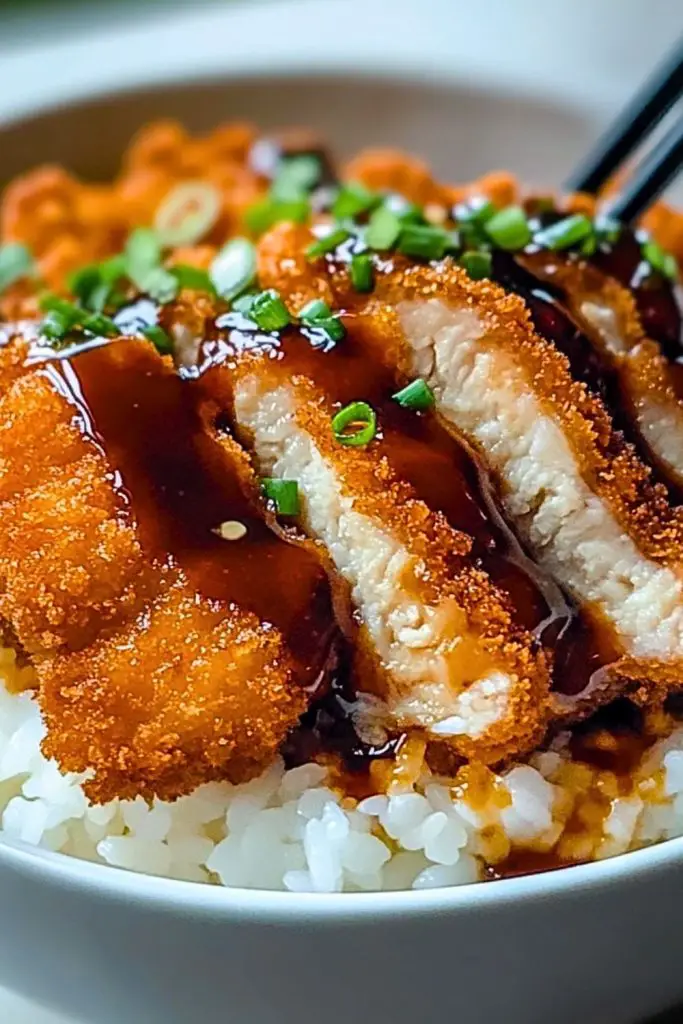Crispy, juicy, and utterly satisfying—Japanese Katsu Bowls with Tonkatsu Sauce are a fusion of texture and flavor that comfort and excite at the same time. This dish features golden breaded pork cutlets, delicately fried to perfection, sliced, and served over a steaming bed of fluffy Japanese rice. The rich, sweet-savory tonkatsu sauce drizzled over the top ties every bite together with bold umami character. Garnished with fresh green onions, it’s a harmony of crunch, warmth, and taste in every spoonful.

These bowls bring a taste of Japan’s home-style cooking straight to your table. Popular in bento boxes, street food stalls, and izakayas alike, katsu bowls deliver comfort food with finesse. Whether you’re preparing a satisfying weeknight dinner or impressing guests with a Japanese-inspired menu, this dish is bound to become a staple in your cooking rotation.
Why You’ll Love This Japanese Katsu Bowls with Tonkatsu Sauce
- Incredible Texture: Crispy panko crust outside, juicy meat inside—exactly how katsu should be.
- Bold Flavor: The tangy-sweet tonkatsu sauce takes this dish to the next level.
- Quick and Satisfying: Minimal prep and a fast fry make this a doable dinner any night.
- Customizable: Swap pork with chicken, tofu, or shrimp to suit your diet or mood.
- Family Favorite: Kids and adults both love the crunchy cutlet and flavorful sauce combo.
Preparation Phase & Tools to Use for Japanese Katsu Bowls with Tonkatsu Sauce
Creating authentic and delicious Japanese Katsu Bowls requires a few key tools and a bit of prep work to ensure your cutlets come out just right. Here’s what you’ll need in your kitchen before diving in:
- Meat Mallet or Rolling Pin: Essential for pounding the pork cutlets to an even thickness. This helps them cook uniformly and remain juicy inside.
- Three Mixing Bowls: One each for flour, egg wash, and panko breadcrumbs. Setting up a proper breading station minimizes mess and speeds up the process.
- Large Skillet or Frying Pan: Choose a heavy-bottomed pan for even heat distribution during frying. A deep skillet helps contain oil splatter.
- Tongs or Chopsticks: Handy for flipping the pork in hot oil safely and with precision.
- Cooling Rack over a Sheet Pan: Letting the fried cutlets rest on a rack keeps them crispy by avoiding steam buildup from sitting directly on paper towels.
- Rice Cooker or Pot with Lid: Perfect rice is the bedrock of a good katsu bowl, so cook it with care.
- Small Saucepan: Needed to simmer and thicken the homemade tonkatsu sauce.
Each of these tools plays a critical role in achieving the right texture, flavor, and presentation. Don’t skip the setup—it makes the cooking smoother and more enjoyable.
Preparation Tips
- Pound Evenly: Don’t rush this part—flattening the pork to ½ inch thickness ensures quick, even frying and a tender bite.
- Chill After Breading: Once coated in panko, refrigerate the cutlets for 10–15 minutes. This helps the crumbs adhere and prevents them from falling off during frying.
- Oil Temperature Matters: Maintain your frying oil around 340–350°F (170–175°C). Too hot and it burns, too cold and it soaks up oil.
- Rice Timing: Start the rice first so it’s done and steaming by the time the katsu is ready. Japanese short-grain or sushi rice gives the best result.
- Don’t Crowd the Pan: Fry in batches to keep the oil temperature stable. Overcrowding leads to greasy, unevenly cooked katsu.
- Drain Strategically: Skip the paper towels and let cutlets rest on a rack for max crunch.
- Use Fresh Panko: Japanese-style panko yields the airiest, crispest crust—worth seeking out over regular breadcrumbs.
Ingredients for Japanese Katsu Bowls with Tonkatsu Sauce
Here’s everything you’ll need to bring this comforting Japanese classic to life. This recipe makes 2–3 generous servings, but can be doubled for more.
For the Pork Katsu:
- 2 boneless pork loin chops (about ½ inch thick)
- ½ teaspoon salt
- ¼ teaspoon ground black pepper
- ½ cup all-purpose flour
- 1 large egg, beaten
- 1 cup Japanese panko breadcrumbs
- Vegetable oil, for frying (such as canola or sunflower oil)
For the Tonkatsu Sauce (Homemade Version):
- 3 tablespoons ketchup
- 1 tablespoon Worcestershire sauce
- 1 tablespoon soy sauce
- 1 tablespoon mirin (or honey if unavailable)
- 1 teaspoon sugar
- ½ teaspoon Dijon mustard (optional, for extra depth)
For the Bowl Assembly:
- 2–3 cups cooked Japanese short-grain rice
- 2 tablespoons chopped green onions or scallions, for garnish
- Optional: Shredded cabbage or pickled vegetables, for added crunch and freshness
These ingredients are easy to find and come together to make a dish that’s rich, crisp, tangy, and deeply satisfying.

Step 1: Prepare the Pork
Start by trimming any excess fat from the pork loin chops. Place each chop between two sheets of plastic wrap or in a zip-top bag and gently pound them to an even ½-inch thickness using a meat mallet or rolling pin. Season both sides with salt and pepper.
Step 2: Set Up a Breading Station
Arrange three shallow bowls:
- One with all-purpose flour.
- One with the beaten egg.
- One with panko breadcrumbs.
Dredge each pork cutlet in flour, shaking off the excess. Dip it into the egg, making sure it’s fully coated. Finally, press it into the panko, ensuring an even, generous crumb layer. Transfer to a plate and repeat with the second cutlet.
Tip: Chill the breaded cutlets for 10–15 minutes in the fridge to help the coating stick.
Step 3: Make the Tonkatsu Sauce
In a small saucepan over medium-low heat, combine ketchup, Worcestershire sauce, soy sauce, mirin, sugar, and mustard (if using). Stir until the sugar dissolves and the sauce gently simmers. Let it cook for 3–4 minutes, stirring occasionally. Remove from heat and set aside.
Step 4: Fry the Pork Cutlets
In a large skillet, heat about ½ inch of vegetable oil over medium heat. The oil is ready when it reaches 340–350°F (170–175°C), or when a panko crumb sizzles immediately upon contact.
Fry each pork cutlet for about 3–4 minutes per side, or until golden brown and cooked through. Transfer to a wire rack to drain and retain crispness.
Step 5: Slice and Assemble the Bowl
Slice the katsu into strips using a sharp knife. Spoon freshly cooked rice into bowls, top with the sliced pork, and drizzle generously with tonkatsu sauce. Garnish with chopped green onions.
Optional: Add shredded cabbage or pickled radish for extra freshness and contrast.
Notes
- Protein Alternatives: While pork is traditional, this recipe works wonderfully with chicken breast, firm tofu, or even shrimp. Just adjust cooking times accordingly.
- Gluten-Free Option: Use gluten-free flour and gluten-free panko (available at many specialty or health food stores), and check that your soy sauce is gluten-free.
- Make-Ahead Tip: The tonkatsu sauce can be prepared in advance and stored in the fridge for up to a week.
- Rice Choice: Short-grain Japanese rice is ideal, but sushi rice or even jasmine rice can be used in a pinch.
Watch Out for These Mistakes While Cooking
- Skipping the Chill Step: Not letting the breaded cutlets rest in the fridge may cause the coating to fall off during frying.
- Using the Wrong Breadcrumbs: Standard breadcrumbs don’t yield the same crispiness as Japanese panko—seek out the real thing.
- Overcrowding the Pan: This drops oil temperature, leading to greasy, soggy katsu. Fry in small batches.
- Undercooking or Overcooking: A meat thermometer can help—aim for an internal temperature of 145°F (63°C) for pork.
- Not Draining Properly: Draining on paper towels can trap steam and soften the crust. A wire rack is your friend here.
- Rushing the Sauce: Let it simmer gently so flavors meld without burning or over-reducing.
- Dry Rice: Improperly cooked or old rice can ruin the bowl. Make sure it’s fresh, fluffy, and warm.
- Using Low-Quality Oil: Neutral, high-smoke point oil like canola or peanut oil ensures clean flavor and proper frying.
What to Serve With Japanese Katsu Bowls with Tonkatsu Sauce?
A great katsu bowl is satisfying on its own, but pairing it with complementary sides elevates the meal to a complete Japanese-inspired dining experience. Here are a few delicious ideas to round out your plate:
8 Recommendations
- Miso Soup
A light, comforting soup with tofu, wakame seaweed, and green onions adds warmth and balances the richness of the katsu. - Pickled Daikon (Takuan)
These sweet, tangy, and crunchy pickles cut through the fried texture beautifully and refresh the palate between bites. - Edamame
Lightly salted boiled soybeans are a simple, protein-packed starter or side that adds a touch of green and crunch. - Japanese Potato Salad
Creamy and slightly sweet, this salad with mashed potatoes, carrots, and cucumbers is a classic accompaniment. - Shredded Cabbage Slaw
Often served with tonkatsu in Japan, this raw cabbage provides crunch and a neutral, fresh contrast to the fried cutlet. - Seaweed Salad
With its sesame-soy dressing and slippery texture, seaweed salad is a textural and flavorful change of pace. - Gyoza (Japanese Dumplings)
Crispy-bottomed dumplings with savory fillings make an irresistible pairing alongside your katsu bowl. - Green Tea or Iced Matcha
For a drink, opt for a refreshing cup of green tea or chilled matcha to cleanse your palate and enhance the meal’s traditional character.
Storage Instructions
Proper storage ensures your Japanese Katsu Bowls with Tonkatsu Sauce remain delicious even as leftovers. Here’s how to store each component separately for the best results:
- Pork Katsu: Let the cutlets cool completely. Wrap them in foil or store in an airtight container in the fridge for up to 3 days. To retain crispiness when reheating, bake in a preheated oven at 375°F (190°C) for about 10–12 minutes or until hot and crispy.
- Cooked Rice: Cool rice quickly and store it in an airtight container for up to 4 days in the fridge. Reheat with a splash of water and microwave covered to revive its fluffy texture.
- Tonkatsu Sauce: Store any leftover sauce in a small airtight jar or container in the refrigerator for up to 1 week. It can be used cold or gently reheated on the stove.
- Do Not Store Assembled Bowls: Assembling everything in advance leads to soggy textures. Store items separately and assemble just before eating.
Estimated Nutrition
The following values are estimated per serving of one complete katsu bowl (including rice and sauce):
- Calories: ~720 kcal
- Protein: ~28g
- Fat: ~36g
- Carbohydrates: ~68g
- Fiber: ~2g
- Sugar: ~10g
- Sodium: ~950mg
Note: These values may vary depending on portion sizes and specific brands used. Tofu or chicken substitutions can slightly alter the nutritional profile.
Frequently Asked Questions
1. Can I use chicken instead of pork?
Absolutely. Chicken breast or thigh works perfectly in place of pork. Simply follow the same steps, adjusting the cooking time to ensure the chicken is cooked through (internal temp of 165°F / 74°C).
2. Is it possible to make this dish vegetarian or vegan?
Yes! Use firm tofu instead of meat. Press it to remove moisture, slice, and bread it just like the pork. For a vegan tonkatsu sauce, skip Worcestershire (contains anchovies) and use soy sauce, ketchup, and a dash of rice vinegar or vegan-friendly substitute.
3. Can I bake the katsu instead of frying it?
You can. Spray breaded cutlets with oil and bake at 400°F (200°C) on a wire rack over a baking sheet for 20–25 minutes, flipping halfway. It won’t be as crispy as frying but is lighter and still tasty.
4. Where can I find authentic panko breadcrumbs?
Look in the Asian aisle of your local supermarket, at Asian grocery stores, or online. Avoid regular breadcrumbs—they’re too fine and don’t crisp up the same way.
5. How do I know the oil is ready for frying?
Drop a pinch of panko into the oil—if it sizzles immediately but doesn’t burn, you’re good. A kitchen thermometer is more precise: aim for 340–350°F (170–175°C).
6. What’s the best way to reheat leftovers without losing crunch?
Use a toaster oven or conventional oven at 375°F (190°C) for 10–12 minutes. Avoid the microwave—it softens the crust.
7. Can I make the tonkatsu sauce in advance?
Yes, it keeps well in the fridge for up to a week. You can even double the batch and store extra for dipping or future katsu bowls.
8. Do I need to serve it with cabbage?
Not required, but shredded cabbage is a classic pairing in Japan. It adds texture and freshness that contrasts beautifully with the fried katsu.
Conclusion
Japanese Katsu Bowls with Tonkatsu Sauce are a glorious blend of crispy, juicy, tangy, and comforting. Whether you’re recreating a favorite from a Japanese restaurant or trying it for the first time at home, this dish is accessible yet indulgent. Each step—pounding the pork, crisping the crust, simmering the sauce—adds layers of love and flavor to the final bowl.
Perfect for a cozy night in, a family dinner, or even meal prep with separate components, this recipe checks all the boxes for a satisfying, crowd-pleasing dish that’s sure to enter your regular rotation.

Japanese Katsu Bowls with Tonkatsu Sauce
- Total Time: 35 minutes
- Yield: 2-3 servings
Description
Golden-fried pork cutlets served over fluffy rice and topped with a rich, sweet-savory tonkatsu sauce. A Japanese comfort dish packed with crispy texture and bold flavor.
Ingredients
For the Pork Katsu:
- 2 boneless pork loin chops (about 1/2 inch thick)
- 1/2 tsp salt
- 1/4 tsp ground black pepper
- 1/2 cup all-purpose flour
- 1 large egg, beaten
- 1 cup Japanese panko breadcrumbs
- Vegetable oil for frying
For the Tonkatsu Sauce:
- 3 tbsp ketchup
- 1 tbsp Worcestershire sauce
- 1 tbsp soy sauce
- 1 tbsp mirin (or honey)
- 1 tsp sugar
- 1/2 tsp Dijon mustard (optional)
For Assembly:
- 2–3 cups cooked Japanese short-grain rice
- 2 tbsp chopped green onions
- Optional: shredded cabbage or pickled vegetables
Instructions
- Trim and pound pork chops to 1/2 inch thickness. Season with salt and pepper.
- Set up breading station with bowls of flour, beaten egg, and panko.
- Coat pork: flour > egg > panko. Press well. Chill for 10–15 mins.
- In a small saucepan, simmer all tonkatsu sauce ingredients for 3–4 mins. Set aside.
- Heat oil in a skillet to 340–350°F (170–175°C). Fry pork cutlets 3–4 mins per side until golden and cooked through.
- Drain on a wire rack. Slice into strips.
- In serving bowls, place rice, top with sliced katsu, drizzle sauce, and garnish with green onions.
- Add cabbage or pickles if desired. Serve immediately.
- Prep Time: 20 minutes
- Cook Time: 15 minutes

